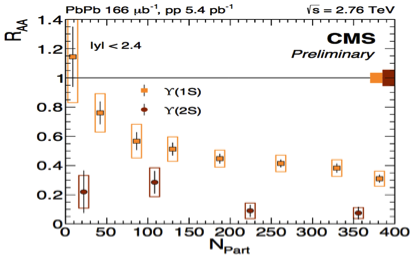CMS results in Hard Probes 2015
CMS has delivered a comprehensive set of differential RAA measurements, quantifying the jet quenching effect for hard probes of various flavors. Profound suppression of strongly interacting probes in 2.76 TeV PbPb collisions is established with high precision for inclusive charged hadrons, spanning the wide range of transverse momenta from soft-sector all the way up to 100 GeV/c, and inclusive fully reconstructed jets, that remain quenched even at 300 GeV/c. It was also found that b-tagged jets in PbPb collisions are suppressed at a similar level to the inclusive (predominantly light) jets in the entire kinematic region studied. First hints of the flavour dependence of energy loss were provided by CMS measurement of displaced J/ψ (from b decays), which shows smaller suppression level compared to light-flavour hadrons below 20 GeV/c. Direct measurements of colourless probes, such as direct photons and W and Z bosons, give a great advantage to CMS nuclear modification studies, providing experimental check of the binary collision scaling for hard processes removing reliance on the Glauber model. The most recent CMS updated result for the Z-boson nuclear modification factor confirms the previously reported RAA of unity for non-interacting probes.
CMS also presented new PbPb Upsilon results, following significant improvements made to the muon reconstruction. Additional and more drastic improvements in the uncertainties of the nuclear modification factor measurements were afforded by a factor of 20 increase in the integrated luminosity of the pp reference. The new 2013 pp data set, corresponding now to 5.4 pb-1 integrated luminosity, allowed more differential studies of Y(1S) and Y(2S) states as a function of collision centrality, Upsilon rapidity and transverse momenta. Strong centrality dependence (Fig.3, left) of Upsilon suppression reported by early CMS measurement is now established with much greater precision. For centrality-integrated (minimum bias) PbPb collisions the Y(1S) are suppressed by about a factor of 2, while the Y(2S) state is diminished by an order of magnitude (the Y(3S) state remains unobserved in PbPb collisions, being suppressed by more than a factor of 7 at 95% confidence level). These suppression levels appear to have no pronounced transverse momenta (Fig.3, right) or rapidity dependence, giving new quantitative input for the theoretical calculations of the melting phenomena.


Figure 1: Collision centrality (left) and transverse momentum (right) dependence of nuclear modification factors for U(1S) and U(2S) bottomonia states from 2.76 TeV PbPb collisions at LHC.
In addition to RAA studies, CMS continues to advance the understanding of jet quenching phenomenon with the suite of correlation studies for fully reconstructed jets. After pioneering the dijet momenta asymmetry measurements in 2011, CMS has attempted to recover the details of the energy loss patterns by measuring event-wide momentum balance about the dijet axis, comparing separately samples of balanced (similar momenta) and unbalanced dijets in pp and PbPb collisions. Formed “missing pT” distributions were studied differentially as function of transverse momenta of all charged particles in the event as well as the radial distance from the dijet axis, reaching out relative radial distance of R = 1.8. Extending the missing-pT measurements to large angles is a crucial first step for constraining the energy loss mechanisms and quantifying the interaction strength within the QGP. High-precision measurements of the background-subtracted jet structures within the jet cone of R = 0.3 performed by CMS for PbPb and pp collisions at the same energy, have shown significant medium-induced modification of both pT and angular distributions in jet shapes and fragmentation functions studies. However, these in-cone changes only account for a fraction of the dijet momentum imbalance.

Figure 2: Total yield excess observed in the PbPb data with respect to the reference measured in pp collisions is shown as a function of associated particle pT in four different centrality intervals for leading and subleading jets.
A new jet-track correlation analysis, separating the jet modifications up to large angles from the long-range correlations of the bulk medium of PbPb collisions, has been presented. The resulting jet-track correlations for back-to-back dijets with leading jet pT > 120 GeV/c and subleading jet pT > 50 GeV/c extend to |Dh,Dj| = 1.5, and are found to be modified compared to the reference measurement in pp collisions.
Peripheral PbPb data are found to have similar jet-track correlation structures as dijets from pp events. For central PbPb data, more charged particles associated with each side of the dijet are found at low transverse momenta (1-2GeV/c), and their angular distributions appear broadened in Δη and Δφ dimensions. The excess of the soft correlated yields is larger on the subleading side of the dijet, which experiences more quenching (summarized in Figure 4). Integrals of the PbPb to pp yield differences are shown for different collision centrality bins, from 50-100% most peripheral events (left) to 0-10% most central PbPb collisions (right). The excess yield and its broadening (not shown) are found to have pronounced centrality dependence, but diminish quickly with increasing particle transverse momentum. At highest transverse momenta studied (up to 8 GeV/c), the correlated yield observed in PbPb collisions becomes similar, if slightly below, to that of the pp reference.
The results summarized here represent only a small fraction of the CMS results presented at Hard Probes 2015. All of the latest CMS heavy-ion results can be found at: https://twiki.cern.ch/twiki/bin/view/CMSPublic/PhysicsResultsHIN.
